Manifold plays white.
Kongo plays black.
Predictor chess.
The game mechanics benefit the player, who predicts opponent's behaviour better.
0. Predictor chess is played with the ordinary chess set: 8 by 8 field and 32 pieces.
1. Game is divided into ply. Each ply is a game state, achieved after simultaneous processing and execution of both players' orders.
2. Before each ply eligible players commit a rule. (In this market black publishes their encrypted move first). The message contains primary and conditional move.
Primary move is a familiar ordinary move. Example: e2-e4.
Conditional move is a set of a) prediction of what the opponent's primary move will happen at the same ply, and b) how to respond to that. Example: if e7-e5 then Nb1-c3.
Conditional move Path cannot be occupied by a piece before the new ply. (You cannot order a classical capture with a conditional move.)
3. Path is a set of all the squares the piece visits when executing its movement, including the target square and not including the starting square. We say that all pieces slide, visiting all squares inbetween. Knight cannot jump over pieces, it slides in a Z pattern.
3.1 We say that paths intersect if they share at least 1 common square.
4. Move orders are processed the following way:
4.1 Primary moves are added to the set of moves to be done (MTBD). Conditional moves are added if their prediction was correct. This always results in a set of length [2, 4] inclusive.
4.2 If pieces attempted to capture each other, both are annihilated and their moves are substracted from mtbd. At this point mtbd might have a length of [0, 4].
4.3 For each move from mtbd draw its path on the board. If different color pieces' paths intersect, both are annihilated and substracted from mtbd. If there are several intersections, (for example, your conditional move crosses both primary and conditional move of your opponent, or all 4 pieces cross a single square) then all the associated pieces are annihilated.
4.4 At this moment only independent moves are supposed to stay in mtbd. All the pieces which are left execute their movements/captures.
4.5 All 4 moves and both predictions (even if incorrect) are highlighted on the map and the new ply is published.
5. If not stated otherwise, normal chess rules apply.
6. En passant can be only performed as a conditional move to the current opponent's primary pawn double move.
Elaboration:
Capturing a rook in a long castling does not affect the double-move of the king. (0-0-0 Rb1 will result in both rooks being annihalated and a king standing on c1.)
Market Management.
Buy Yes shares to become an eligible white team player.
Kongo plays black and has to publish his move order first, cyphered.
When the time dedicated for a ply ends, I will look through commited moves and take the move from the highest shareholder from white team. If highest did not commit a move, then the second highest is picked and so on.
I will actively prevent sabotage and metagaming, even if I would need to contradict already established rules of the market and rewrite them.
Each ply (boardstate picture and most recent orders) will be published in the comments.
Recent update:
Added Elaboration 1 about castling.
Replaced "target square" with "Path" in rule 2. That change prevents discovered instant attacks.
🏅 Top traders
| # | Name | Total profit |
|---|---|---|
| 1 | Ṁ413 | |
| 2 | Ṁ54 | |
| 3 | Ṁ23 | |
| 4 | Ṁ4 | |
| 5 | Ṁ0 |
People are also trading
@traders I give up. Lost queen and any counterthreat.
If you are interested in my chess-related markets, visit /KongoLandwalker/fog-of-war-chess-simulation-will-yo
White move 11:
PxQ and if Nf6 then Bf3
Black move 11:
move11:Qxe3+,if[Qe8]then[Kf8]
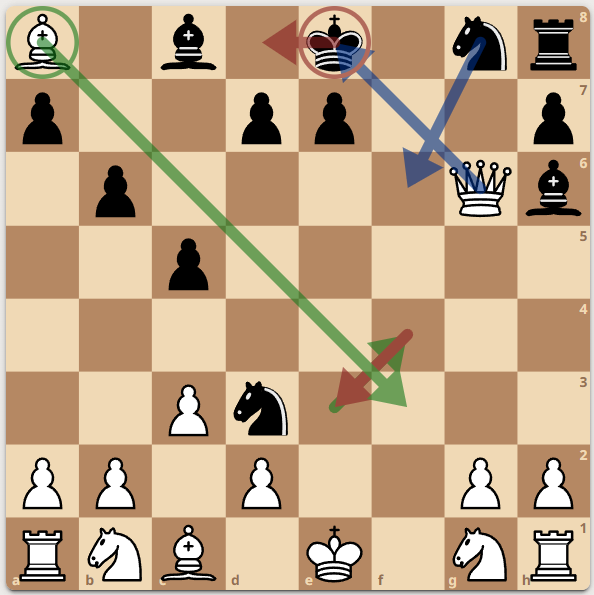
Black move 12:
2e5a34397b4d363c3b086524c3017768198160c810d9deb8dfb9354c3510dc19
The red conditional arrow is incorrect. Picture above shows d8, but the move is f8.
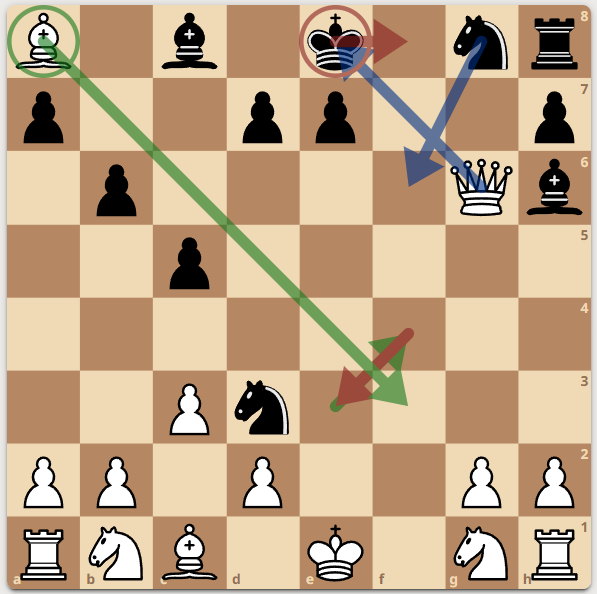
@ChristopherRandles It seems I didn’t see your last messages, I’ll try to check that as soon as I can
@KongoLandwalker I’m trying to keep up but get overwhelmed and too forgetful. I am hereby waiving my 1st shareholder rights and allowing @ChristopherRandles to submit white moves without supplementary approval of mine.
@Mich
I am still not getting your message(s) in last 2 weeks, we need to find another way to communicate. I gave my discord details below. If that doesn't work for you, some other means seems needed.
White move 10:
Qxg6+ and if Qg3 then g3
Black move 10:
move10:Qf4,if[Qg4]then[d5]
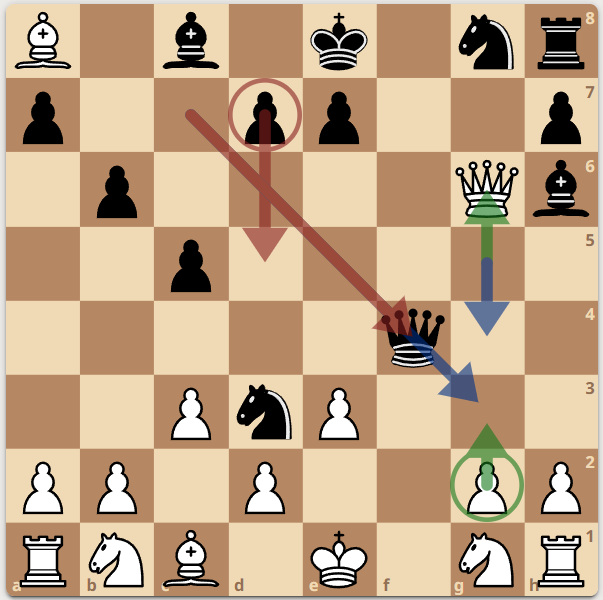
Because it is relevant, i will repeat elaboration from before:
Winning criteria is not stated, so it comes from ordinary chess: failing to defend a king is a loss.
If under a check, you have to do something to prevent potential capture (move away/block the sightline/do appropriate conditional interception). If cannot prevent potential capture, that is a checkmate.
I HAVE TO deal with Qxe8 (one of the 2 potential captures of the king in this position), even if it is not the move you will try to do. Second potential capture would be pair of moves Kf7 and (Qxe8 or Qf7). So I cannot perform Kf7 (even if i think you will move Q elsewhere), because it is also a potential capture.
At the same time white SHOULD do (does not have to if decides to gamble) something about Qf1 (checkmate in 1). Capturing the queen with a king is a potential mutual annihilation, all other squares around the king would be walking into check.
Black is thinking...
[Mistake was here]
Best to try to make sure we understand the rules.
If the situation was

Without the B is this checkmate as only legal move is KxQ and this does not defend against QxK?
With the B, can white play BxQ and if QxK then Kg5?
Kg5 is illegal in this situation but white should get a move for guessing QxK correctly. The Kg5 would be legal if black queen is taken or played to say g3.
Your suggestion that Kd1 is possible, a move that would keep K in check suggests than a conditional Kg3/5 is allowed? Or is Kd1 allowed only because it is not attacked from the situation with the Q on f1 and K on e1?
So is there restriction on playing Kd1 can it be on primary or conditional or either?
Best to try to make sure we understand the rules.
I did not think through some of the cases and i feel will now be flooded with flaws of the ruleset the closer the end is.
For example, I did not think about situations where there are no other pieces to make a conditional move. What if Only king is left in the army, but he is not under check? I think it is a stalemate, because a player cannot make a legal move (which has to include primary and conditional).
Without the B is this checkmate as only legal move is KxQ and this does not defend against QxK?
Yes, that was my logic.
With the B, can white play BxQ and if QxK then Kg5?
I see the confusion. This combo looks like it prevents any posibility the king is captured.
If queen stays, it gets captured. King is alive.
If queen attacks King, he steps away, alive.
If queen makes any other move - it is not intersecting with the king. He is alive.
BUT the king is still targeting a square which is currently under attack, which is forbidden by normal chess. Conditional move should also satisfy normal chess move restriction. Whether the move is legal is decided before the move.
And that shows that I was incorrect about Kd1 on our board, so Qf1 is in fact a checkmate, if not dealt with. No matter primary or conditional move king makes, that d1 square is not considered safe in normal chess when Q is of f1.
...
I might be missing sth. Tell me if anything is contradictory. I am puzzled, the concept of this game is so difficult to convey that I feel we will find more ambiguities.
Now the game feels like atomic chess. Queen alone can checkmate in many more ways than ordinary...
>I think it is a stalemate,
Is the position shown a stalemate or is there another move?
I am thinking
If black plays QxK and if BxQ then a K move while White plays BxQ and if QxK then white claims stalemate then it is stalemate.
However black might want to avoid stalemate so plays something different maybe Qf4 hoping to pin the B then take it next move. If white guesses this Is KxQ and if Qf4 then Qe5+ a possible move?
.
Suppose one side has K and a P that cannot move. Can that player play:
K somewhere and if [guess of opponents move] then claim stalemate?
So I don't think you want the position I proposed to be stalemate, it should only be stalemate if/when the guess of opponents move is correct
.
If both sides Ks are in check, is a move that attempts to take K legal providing secondary move is to deal with their K being taken? Or is a conditional defence not allowed if it might not guess the move and leave the K in check?
My talk about stalemate was irrelevant to your position. I said it in the example of ONLY king is left. I think you read my message incorrectly, reread it please as it is two different parts: one about stalemate and one answering your questions.
___
If black plays QxK and if BxQ then a K move while White plays BxQ and if QxK then white claims stalemate then it is stalemate.
Does not make sense to me. Position is a checkmate.
Claiming a stalemate is not a move in normal chess, stalemate is an automatic result deduced from the position. So any "if Qa1 then stalemate" types of moves do not exist.
Whether situation is a stalemate or not should be checked by looking at the position, not at the conditional move attempt. You have to declare a primary and conditional move every time, if it is impossible in some position, it is a stalemate. On your board example I do not see a single way to Guarantee that the king survives AND does not land(attemt to land) on a currently attacked space (which is forbidden by normal chess), so it is checkmate.
Suppose one side has K and a P that cannot move. Can that player play:
K somewhere and if [guess of opponents move] then claim stalemate?
This is stalemate automatically, the game has ended and players do not make any further moves or predictions.
If white guesses this Is KxQ and if Qf4 then Qe5+ a possible move?
No, KxQ is not a safe move in this variant. While dealing with check you have to guarantee that King survives/escapes all current threats (QxK is one of them, because our rules say mutual annihilation exists) AND does not land on a currently unsafe space (inherited from normal chess).
So I don't think you want the position I proposed to be stalemate, it should only be stalemate if/when the guess of opponents move is correct
YOUR board is a checkmate, stalemate was a general example (irrelevant to your board) with only one king left who is not in check.
Stalemate is a board state, it does not depend on guesses.
If both sides Ks are in check, is a move that attempts to take K legal providing secondary move is to deal with their K being taken? Or is a conditional defence not allowed if it might not guess the move and leave the K in check?
1) Yes, if that conditional move is legal: guarantees the king is not captured AND lands on a safe and legal space - which is not currently attacked, not currently occupied by another piece.
If some move guarantees the King is not captured, but he walks into a currently attacked space - it is not a legal move. You cannot walk into check.
2) Conditional escape is allowed, but the king has to land on a safe space. Conditional interception is allowed, if it guarantees the king will not be instantly captured (even if you do not guess), even if king stays on the same spot.
Consider the following board, let's call it 02:
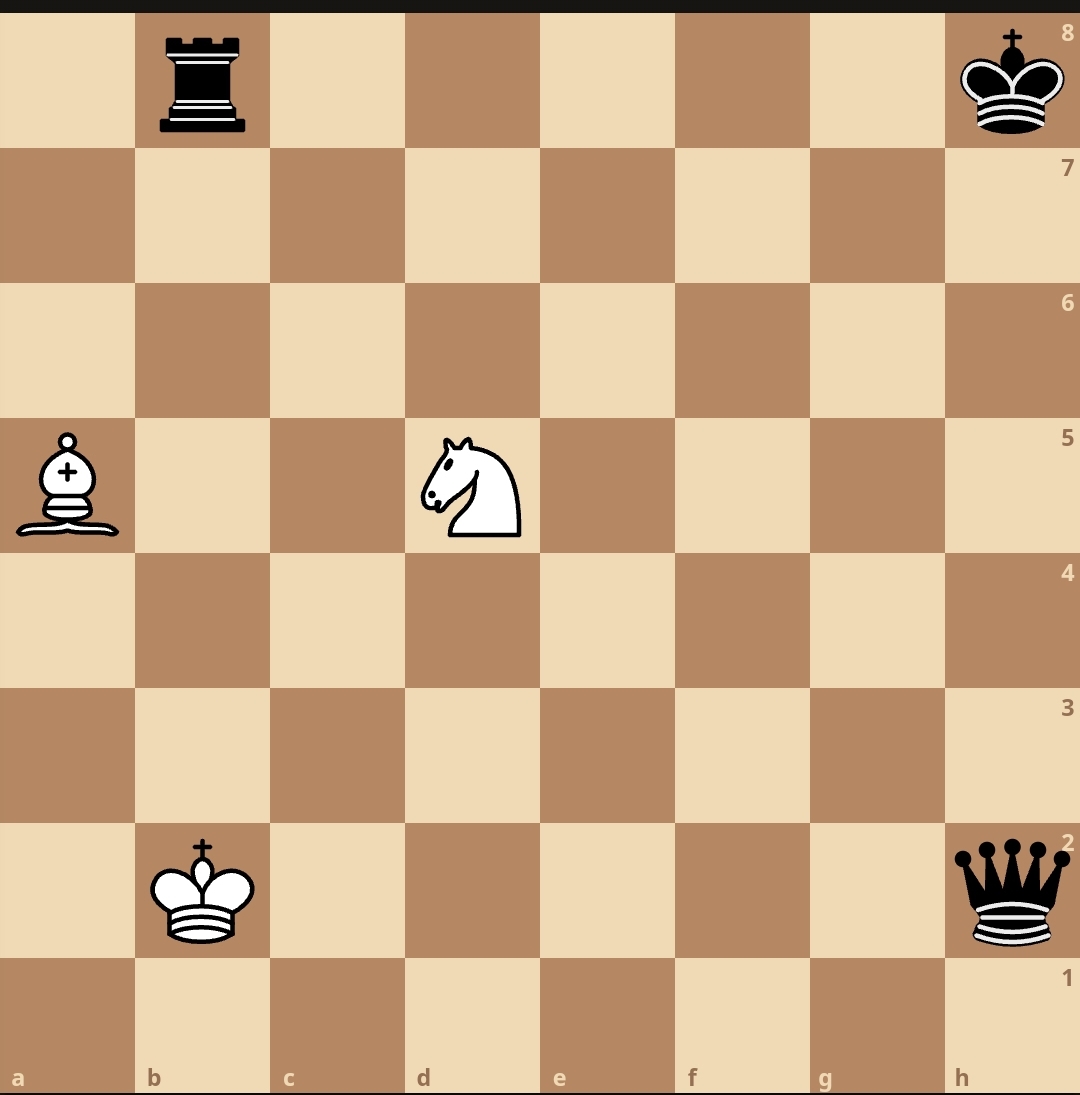
King is in double check. He could just make Ka1 primary and deal with both, but let's discuss moves relevant to this game.
Discussing white opportunities:
"Be1, if Rxb2 then Nf6" is a legal move. Bishop would intercept any capture of the king. And king does not walk into new checks.
"Nf6, if Rxb2 then Ka1" not legal, does not deal with all the threats: queen could capture the king.
"Nb4, if Qxb2 then Ka2" not legal, as king walks into currently unsafe space by normal chess rules (Ka2 is illegal by itself, no matter whether it is conditional or primary).
"Nb4, if Qxb2 then Ka1" is legal, as it prevents from rook capture and walks away from queen if she dares to capture.
Staying "in check" but preventing all possible king captures is fine, but walking into new threat is not fine. That is needed to prevent an endgame, where king just jumps between spaces, attacked by a queen, making conditional moves to escape endlessly, just by assuming queen tries to capture every move.
We could ban "staying in check" (the first move option with Be1) if it is unintuitive, but in my opinion it deletes an interesting mechanic which this game was created for.
By "Staying in check" you risk to lose your piece, so it cannot be used to stall the game, opponent can sacrifice his piece to open path (or on this board 02 he could pass through black squares by his queen).
"Walking into check" can literally create an uncatchable king in many endgames.
How should I update the rules to convey that threat-dealing paradigm concisely?
I think I follow, a slight wrinkle:
position o2
>"Nb4, if Qxb2 then Ka2" not legal, as king walks into currently unsafe space by normal chess rules (Ka2 is illegal by itself, no matter whether it is conditional or primary).
Can Bd2 and if Rxb2 then Ka2 be played?
This deals with both threats, the K cannot be captured but the K conditionally moves to a2.
If that is possible, it would appear your "no matter whether it is conditional" should be changed to 'Ka2 is always illegal as primary but also illegal as conditional unless something is placed in the way on second rank by the primary move.
Can Bd2 and if Rxb2 then Ka2 be played?
This deals with both threats, the K cannot be captured but the K conditionally moves to a2.
According to what i have imagined it is not a legal move.
Making exception for this type of situation complicates things.
"King should not land on a currently attacked space" is simplier.
>"What if Only king is left in the army, but he is not under check? I think it is a stalemate, because a player cannot make a legal move (which has to include primary and conditional)."
This covers not check and only one piece can move.
If all pieces have no moves and under check is obviously checkmate.
That doesn't cover all situations, I think this leaves
1. King is in check but has one or more moves that can be made as primary move but there is no possible secondary move.
2. King is in check and there is no primary move but there is a possible secondary move in response to the only King capture. However I cannot see how this is possible.
A couple of examples of 1:
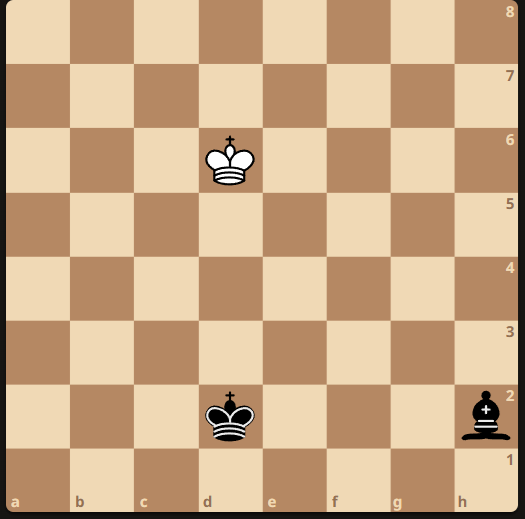
Is this checkmate or stalemate or stalemate after white plays something impossible like Kc5 and if Kh1 then Kc6?
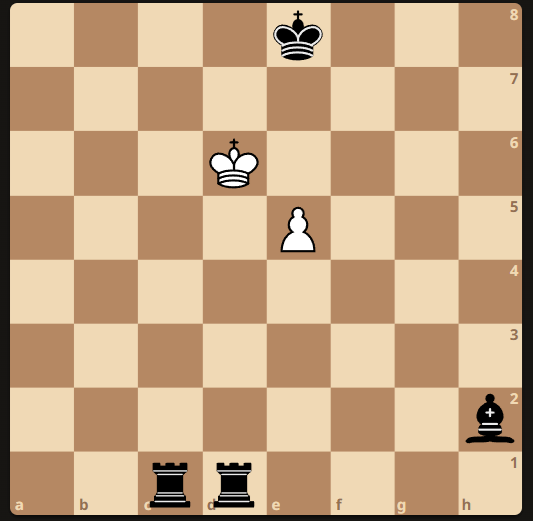
Can white play Ke6 and if Rd6 then PxR? That is conventional capture with secondary move which is prohibited so that appears to be not allowed.
I also think that Pe6 and if Re1 then Kd5 is not allowed re both walking into discovered check and Kd5 is not possible with current position.
Is this checkmate or stalemate?
1. King is in check but has one or more moves that can be made as primary move but there is no possible secondary move.
Ckeckmate. King under the check and player cannot make a legal move (which HAS to include primary n conditional)
2. King is in check and there is no primary move but there is a possible secondary move in response to the only King capture. However I cannot see how this is possible.
Checkmate for the same reason.
Both examples look like checkmates to me.
Can white play Ke6 and if Rd6 then PxR?
PxR is illegal, All the moves have to be done with the consideration of the current position (not the one which we expect or the one which will be after half-execution of the orders). There is a King on d6, so pawn cannot capture his own king, cannot walk there.
Also it breaks "Conditional move Path cannot be occupied by a piece before the new ply."
I also think that Pe6 and if Re1 then Kd5 is not allowed re both walking into discovered check and Kd5 is not possible with current position.
Pawn just cannot move in this position, because in normal chess discovering attack on your own king is banned.
And yes, Kd5 is illegal.
Messages still seem patchy. I can see first line of message from Mich on messages but choosing Mich doesn't display it. Not sure if @Mich can send again or if it will show up sometime soon.
Have you considered discord for your discussions?